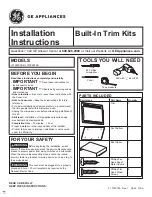
6.1.2 Planning the electrical installation
Meaning
It is crucial to the safe and reliable operation of the appliance that the electrical system is installed
carefully and correctly. All the rules and regulations listed here, and the described procedure, must be
strictly followed.
Rules for safe electrical installation of the appliances
Observe the following rules to prevent hazards caused by faulty electrical connections:
The case of the appliance must be grounded in a suitable manner and connected to an equipoten‐
tial bonding system.
If two table-top units are installed in a stacking kit, both cases of the appliances and the stacking kit
itself must be grounded in a suitable manner and connected to an equipotential bonding system.
For table-top units on a wheeled platform, the length of the mains power lead must accommodate
the range of movement allowed to the appliance by the retaining device on the wheeled platform.
When moving the assembly (platform plus appliance), never strain or wheel over the mains supply
cable.
All electrical connections must be checked when the appliance is prepared for first-time use to en‐
sure cables are laid correctly and connections are made properly.
Equipment provided by customer and electrical installation regulations
The table below shows what equipment must be provided by the customer and what regulations must
be observed when connecting the appliance.
Equipment
Regulations
Fuse
Fuse protection and connection of the appliance must comply with local
regulations and national installation requirements.
Equipotential bonding
The appliance must be incorporated in an equipotential bonding system.
Equipotential bonding: electrical connection that ensures that the frames
of electrical equipment and any external conductive components are at an
equal (or practically equal) potential.
Ground fault circuit inter‐
rupter
(GFCI)
If the installation regulations require protection by a residual-current de‐
vice (RCD), then suitable residual-current devices meeting the relevant
national regulations must be used.
If the installation includes more than one appliance, one residual-current
device must be provided for each appliance.
Disconnection device
An easily accessible all-pole disconnection device with a minimum contact
separation of 3 mm must be installed close to the appliance. The appli‐
ance must be connected via this disconnection device.
The disconnection device is used to disconnect the appliance from the
electrical supply for cleaning, repair and installation work.
6 Installation
Installation manual
72
















































